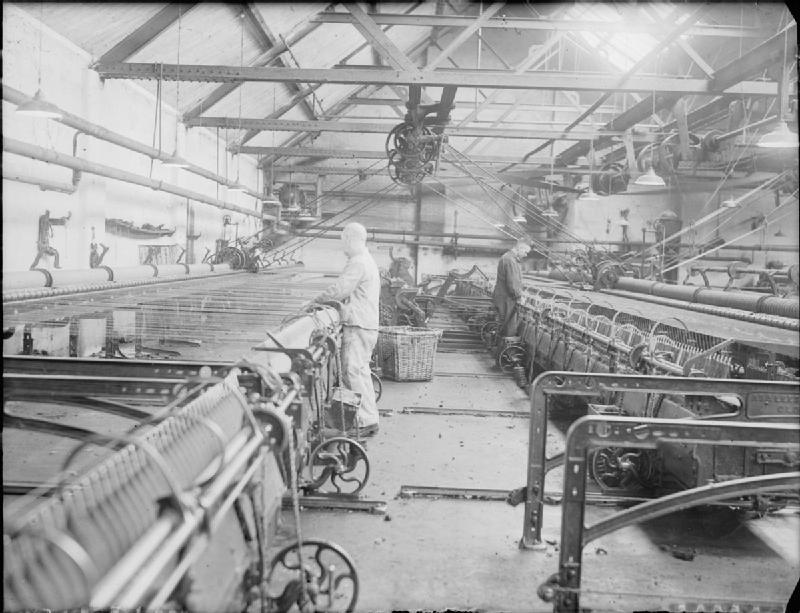Today’s Woolness Words post is excerpted from a chapter of the same name in William J. Claxton’s children’s reference book, Wool and the Weaver, Rambles among our Industries. We felt that – like yesterday’s Woolness Words from Rachael Matthews – it would offer a different perspective or framing for our forthcoming week of posts themed around Woolness & the Locale.

Mill workers man large yarn spinning machines at the mill of C and J Hirst and Sons Ltd. in Huddersfield. These machines spin wool into yarn, which will then be woven into cloth. Author: Ministry of Information Photo Division Photographer. Image held in Wikimedia Commons here
In a Woollen Town
Let us pay a visit to one of the largest towns in the West Riding of Yorkshire where King Wool makes his home. You may have read in your geography books that Yorkshire is a land of moors and mountains, with beautiful valleys and sparkling rivers. If you expect to see any of this fine scenery near the busy woollen towns, you will be sadly disappointed. As a rule there is a dreary, drab sameness about that part of a woollen town where the mills are built and where the wool combers, and carders and spinners and weavers work. The factories are grimy with smoke, the walls are weather beaten and the woodwork of the huge gateways sadly need paint. Most of the wool workers houses stand back to back, and row after row of them are alike. No thought of “Garden Cities” here! “Use, not ornament”, seems to be the proverb which builders bore in mind when planning the woollen quarters of the largest towns.
[…]
Let us walk along one of these narrow and rather dreary streets between five and six o’clock in the morning. The great chimneys which tower high above the blank walls of a large woollen mill are painting the sky black with their smoke. Sirens shriek and hooters blow. From north, south, east and west, crowds of women and girls, with a fair sprinkling of boys and med, stream along to the large gates of the mill. We may well compare the main street, which runs along the high walls of the woollen mill with a river, and the smaller streets leading into it, with the rivers tributaries. The hundreds and thousands of busy workers are the human stream, which flows through the gates and swallows them up.
As the day shift – in which most of the people are women, girls and boys – is entering, the night shift is leaving off and going home to a well-earned rest. […] Nearly all the workers carry cans, which, in the case of those entering the mill, are filled with tea or coffee. Possibly some of the workers live in the suburbs of the town, or even in the villages some miles away and so they stay in the mill for their meals. Tramcars run in all directions, and of late years many of the wool-workers have moved farther out of the squalid, dirty roads into the purer air of the village on the hills.
[…]
Possible the long hours which wool-workers have to work make them enjoy their pleasures more than most people who have more spare time. On Saturday afternoons in the winter, the football grounds are crowded with eager onlookers, most of whom have been at work in the mills all week. Nearly every village in the West Riding has its band. And in the summer, when large numbers of mill lads and lasses take their annual holidays and go to New Brighton, Blackpool or some other holiday resort, one would never think that they had a care in the world. For a few glorious days of the siren’s screech is forgotten; the stifling, stuffy carding and combing rooms give place to the majestic mountain scenery or the sands of the seashore.
Claxton, William J. Wool and the Weaver, Rambles among our Industries. Blackie and Son Limited, 1930. P75-80
